ACUFO-1945-06-09-NAGOYA-1
In the U.S. Army Air Forces XXIst Bomber Command Tactical Mission Report for Mission No. 193 flown on June 9, 1945, we learn that the units were the 58th and the 131th Bombardment Wings, the planes were B-29. Initial point was over Iwo Jima, the target was Nagoya.
The target was reached first at 08:30 a.m. and last at 09:23 a.m. local time, by day.
In the “Enemy Anti-Aircraft” intelligence section of this mission report, in a special “Miscellaneous” anti-aircraft section, the report indicated that near the head of Nagoya Bay and also near Toyohashi Airfield, strange “reflector-like objects” arranged in groups of two and three, were reported. There were 6 to 8 in each area and they had a circular appearance; their size was not determined.
As an analysis of this event, the Part IV of the report's Annex told that the “reflectors” issue had been the topic of a “Special Report on Test Searchlight Mission”, prepared by the XXIst Bomber Command Central Interpretation unit on June 20, 1945 and a the topic of a report by the Intelligence Officer, 3rd photo reconnaissance Squadron on 14 June 1945.
It was told that these studies “are on outgrowth of aircrew reports, beginning late in 1944, of “reflectors” on the island of Honshu, first reported as circular and stationary, later as following the flight line of the aircraft, while other reports were of rectangular “reflectors” with a width-length ratio of one to four.
The Air Forces told that they tried in vain to correlate these observations with enemy antiaircraft, radar and radio activity and/or interference.
The study was continued, however, in view that it could be “a new type of Japanese equipment still in the embryonic state, although it was generally believed that these 'reflectors' were a natural phenomena.”
The report of the 3rd Photo Reconnaissance Squadron, “whose crews made the original and most frequent observations”, was of a test flight they conducted at the request of Lt. Col. Nadeau, Staff Photo Officer of XXI Bomber Command in order to determine whether the “reflectors” which “had been reported by reconnaissance and bomber crews” could be Japanese searchlights trained on and following the aircraft. The aircraft used was a F-13A, number 42-93856, with all cameras installed. The airplane commander and crew had observed the “reflectors in Japan many times and have on all occasions proved to be complete and accurate in their observations.”
The airplane commander stated that the impression he had gotten from the test was that the reflectors seen over Japan were “very similar in appearance and behavior to those produced by our tracking searchlights. The exceptions were two: the Japanese reflections are, on the average, much larger than our lights and seemed to have a copperish tinge, as contrasted to the bluish-white beam of our searchlights. It is, in his opinion, highly possible that the reported reflections over Japan were caused by searchlights. He further stated that the searchlights were able to track him quite accurately until the aircraft reached 25,000 feet at that altitude several seconds were consumed in hunting for the aircraft. However, once the beam caught the aircraft it stayed.”
A staff Sergeant Joseph Czermink, tail gunner, corroborated this and mentioned that the peculiar coppery color of the Japanese reflections had particularly impressed him.
Left blister gunner, Technical Sergeant George Vandal, commented that when the beam of the searchlight was not on the aircraft but the spot of light on the ground could be seen as if the beam were being aimed to the front or rear of the aircraft, the resemblance appeared quite strong. However, when the aircraft was directly in the beam, the two reflections, Japanese and searchlight, were dissimilar. Others joined similar comments.
One instance was cited where “reflectors” were photographed, but were determined to be “reflections” probably caused “by rays of the sun striking the roofs of several building near Hamamatsu;” buildings that may have been glass-roofed greenhouses.
| Date: | June 9, 1945 |
|---|---|
| Time: | Between 08:30 a.m. and 09:23 a.m. |
| Duration: | ? |
| First known report date: | June 9, 2023 |
| Reporting delay: | Hours. |
| Country: | Japan |
|---|---|
| State/Department: | Aichi |
| City or place: | Nagoya |
| Number of alleged witnesses: | Several. |
|---|---|
| Number of known witnesses: | 2 or more. |
| Number of named witnesses: | 0 |
| Reporting channel: | Military operations report. |
|---|---|
| Visibility conditions: | Day. |
| UFO observed: | Yes. |
| UFO arrival observed: | ? |
| UFO departure observed: | ? |
| UFO action: | ? |
| Witnesses action: | |
| Photographs: | No. |
| Sketch(s) by witness(es): | No. |
| Sketch(es) approved by witness(es): | No. |
| Witness(es) feelings: | ? |
| Witnesses interpretation: | "Reflectors". |
| Sensors: |
[X] Visual: Several.
[ ] Airborne radar: [ ] Directional ground radar: [ ] Height finder ground radar: [ ] Photo: [ ] Film/video: [ ] EM Effects: [ ] Failures: [ ] Damages: |
|---|---|
| Hynek: | DD |
| Armed / unarmed: | Armed, 12 Browning M2 12.7 mm machine guns. |
| Reliability 1-3: | 3 |
| Strangeness 1-3: | 2 |
| ACUFO: | Possible extraterrestrial craft, insufficient information. |
[Ref. aaf1:] US ARMY AIR FORCES:
In the XXIst Bomber Command Tactical Mission Report for Mission 193 flown on June 9, 1945, we learn that the units were the 58th and the 131th Bombardment Wings, the planes were B-29. Initial point was over Iwo Jima, the target was Nagoya.
The target was reached first at 082330Z (08:30 a.m. local time) and last at 090023Z (09:23 a.m. local time), by day.
In the “Enemy Anti-Aircraft” intelligence section of Mission 193, in a special “Miscellaneous A/A”, the report indicated:
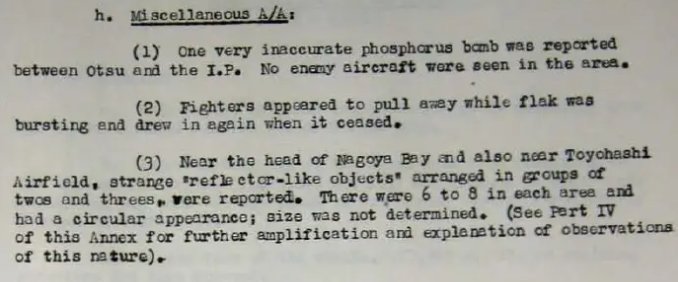
|
(3) Near the head of Nagoya Bay and also near Toyohashi Airfield, strange “reflector-like objects” arranged in groups of two and three, were reported. There were 6 to 8 in each area and had a circular appearance; size was not determined. (See Part IV of this Annex for further amplification and explanation of observations of this nature).
The Part IV of the report's Annex was:
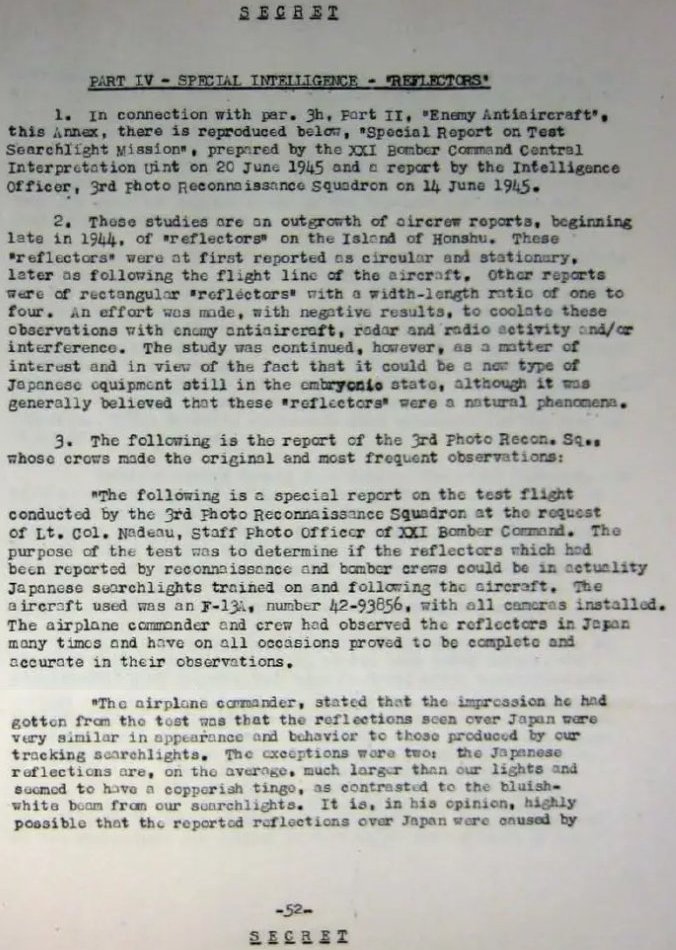
|
SECRET
PART IV - SPECIAL INTELLIGENCE - "REFLECTORS"
1. In connection with par. 3h, Part II, “Enemy Antiaircraft”, this Annex, there is reproduced below, “Special Report on Test Searchlight Mission”, prepared by the XXI Bomber Command Central Interpretation unit on 20 june 1945 and a report by the Intelligence Officer, 3rd photo reconnaissance Squadron on 14 June 1945.
2. These studies are on outgrowth of aircrew reports, beginning late in 1944, of “reflectors” on the island of Hunshu. these “reflectors” were at first reported as circular and stationary, later as following the flight line of the aircraft. Other reports were of rectangular “reflectors” with a width-length ratio of one to four. An effort was made, with negative results, to coolate [sic, correlate] these observation with enemy antiaircraft, radar and radio activity and/or interference. The study was continued, however, as a matter of interest and in view of the fact that it could be a new type of Japanese equipment still in the embryonic state, although it was generally believed that these “reflectors” were a natural phenomena.
3. The following is the report of the 3rd Photo Recon. Sq., whose crews made the original and most frequent observations:
“The following is a special report on the test flight conducted by the 3rd Photo Reconnaissance Squadron at the request of Lt. Col. Nadeau, Staff Photo Officer of XXI Bomber Command. The purpose of the test was to determine if the reflectors which had been reported by reconnaissance and bomber crews could be in actuality Japanese searchlights trained on and following the aircraft. The aircraft used was a F-13A, number 42-93856, with all cameras installed. The airplane commander and crew had observed the reflectors in Japan many times and have on all occasions proved to be complete and accurate in their observations.
“The airplane commander, stated that the impression he had gotten from the test was that the reflectors seen over Japan were very similar in appearance and behavior to those produced by our tracking searchlights. The exceptions were two: the Japanese reflections are, on the average, much larger than our lights and seemed to have a copperish tinge, as contrasted to the bluish-white beam of our searchlights. It is, in his opinion, highly possible that the reported reflections over Japan were caused by
-52-
SECRET
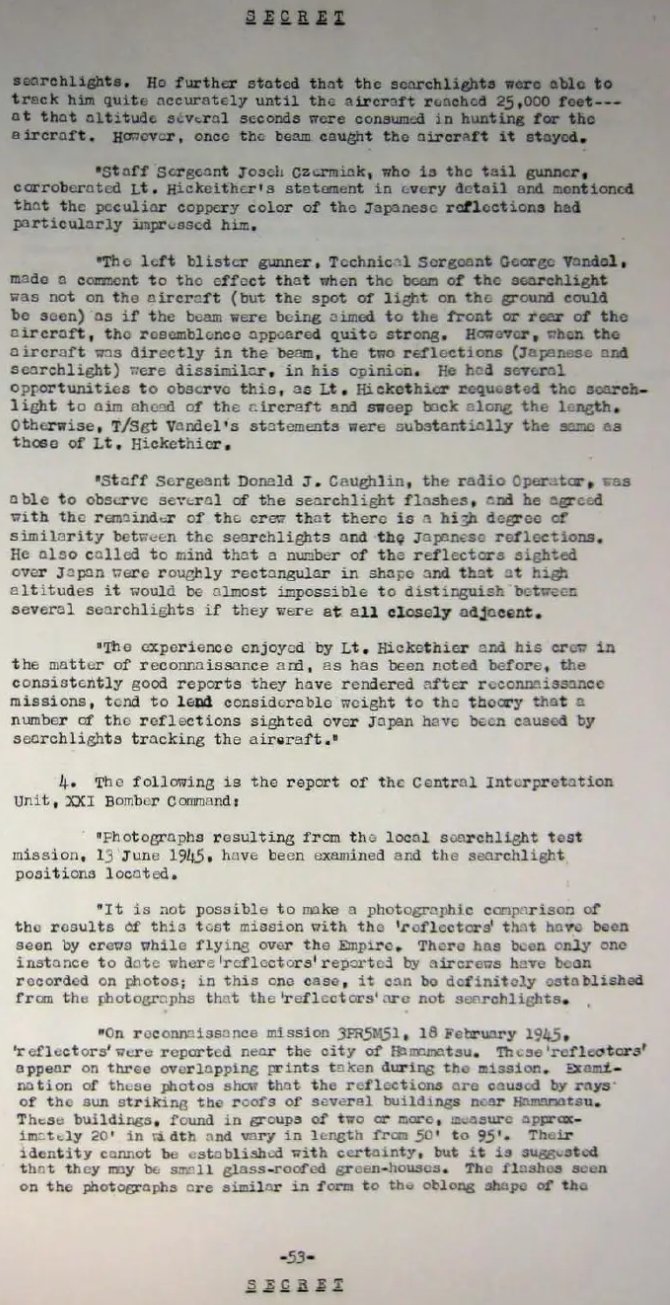
|
SECRET
searchlights. He further stated that the searchlights were able to track him quite accurately until the aircraft reached 25,000 feet --- at that altitude several seconds were consumed in hunting for the aircraft. However, once the beam caught the aircraft it stayed.
“Staff Sergeant Joseph Czermink, who is the tail gunner, corroborated Lt. Hickeither's statement in every detail and mentioned that the peculiar coppery color of the Japanese reflections had particularly impressed him.
“The left blister gunner, Technical Sergeant George Vandal, made a comment to the effect that when the beam of the searchlight was not on the aircraft (but the spot of light on the ground could be seen) as if the beam were being aimed to the front or rear of the aircraft, the resemblance appeared quite strong. However, when the aircraft was directly in the beam, the two reflections (Japanese and searchlight) were dissimilar, in his opinion. Hickethier requested the searchlight to aim ahead of the aircraft and sweep back along the length. Otherwise, T/Sgt Vandel's statements were substantially the same as those of Lt. Hickethier.
“Staff Sergeant Donald J. Caughlinh, the radio Operator, was able to observe several of the searchlights flashed, and he agreed with the remainder of the crew that there is a high degree of similarity between the searchlights and the Japanese reflections. He also called to mind that a number of the reflectors sighted over Japan were roughly rectangular in shape and that at high altitudes it would be almost impossible to distinguish between several searchlights if they were all closely adjacent.
“The experience enjoyed by Lt. Hickethier and his crew in the matter of reconnaissance and, as had been noted before, the consistently good reports they have rendered after reconnaissance missions, tend to lend considerable weight to the theory that a number of the reflectors sighted over Japan have been caused by searchlight tracking the aircraft.”
4. The following is the report of the Central Interpretation Unit, XXI Bomb command:
“Photographs resulting from the local searchlight test mission, 13 June 1945, have been examined and the searchlight positions located.
“It is not possible to make a photographic comparison of the results of this test mission with the “reflectors” that have been seen by crews while flying over the Empire. There has been only one instance to date where “reflectors” reported by aircrews have been recorded on photos; in this one case, it can be definitely established from the photographs that the “Reflectors” are not searchlights.
“On reconnaissance mission 3FR5M51, 18 February 1945, “reflectors” were reported near the city of Hamamatsu. These “reflectors” appear on three overlapping prints taken during the mission. Examination of these photos whow that the reflections are caused by rays of the sun striking the roofs of several building near Hamamatsu. These building, found in groups of two or more, measure approximately 20' in width and vary in length from 50' to 95'. Their identity cannot be established with certainty, but it is suggested that they may be glass-roofed green-houses. The flashed seen on the photographs are similar in form to the oblong shape of the
-53-
SECRET
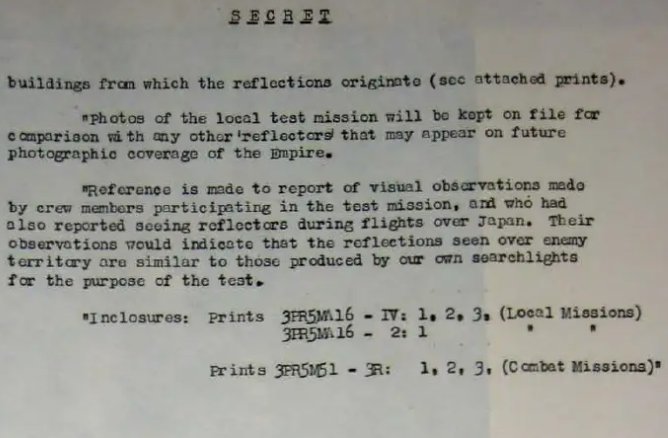
|
SECRET
buildings from which the reflections originate (see attached prints).
* Photos of the local test mission will be kept on file for a comparison with any other “reflectors” that may appear on future photographic coverage of the Empire.
“Reference is made to report of visual observations made by crew members participating in the test mission, and who had also reported seeing reflectors during flights over Japan. Their observations would indicate that the reflections seen over enemy territory are similar to those produced by our own searchlights for the purpose of the test.
* Enclosure: Prints 3PR5MV16 - IV: 1, 2, 3, (local Missions) 3PR5MV16 - 2:1 (local Missions)
Prints: 3PR5M51 - 3R: 1, 2, 3, (local Missions)*
The Boeing B-29 “Superfortress” was the heaviest bomber of the U.S. Army Air Forces, used in operations from May 8, 1944 and on. Its maximum speed was 574 km/h.
Its defensive armament was 12 Browning M2 12.7 mm machine guns.
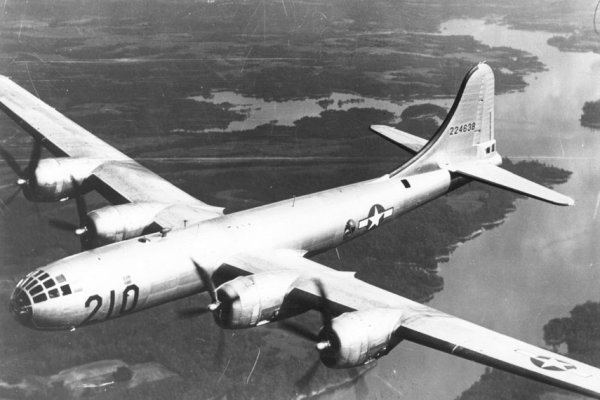
|

|
I was quite stunned when reading the observation report: although really brief, it seems to me that if it had taken place after 1947, the year of the beginning of the media era of “flying saucers”, one would have referred to these objects as “flying discs”. One would have spoken there of “daylight discs”, to use the famous Hynek classification.
But obviously, during World War II, there was no talk of flying saucers, UFOs, flying discs, and the like.
Equally remarkable, the mission report exceptionally includes an annex, which sets out no less than a search for ordinary explanation similar to the searches for ordinary explanations carried out years later in the era of the “Unidenified Flying Objects.”
And to my knowledge, neither this case nor this research has ever been cited in the UFO literature.
It is difficult to say what the “reflectors” described in the mission report were. This happened in daylight, and this time, it was not about “balls of fire”. The “Reflectors” can only refer to objects that reflect light, such as metallic ones.
The report lacks details, and one could argue that these were barrage balloons or enemy planes reflecting the sun. However, the arrangement “in groups of two or three”, with “6 to 8” of these groups “in each zone”, hardly corresponds to this. And above all, this is not at all the direction where Air Intelligence is leading us with their report on “reflectors”.
The observation report gives us neither altitude, nor duration, nor indications of immobility or movement of the “reflectors”. Why are there so few details? To me, the military logic of the report is that it was not useful, since an report evaluating the “reflectors” existed. The evaluation report was appended, considering that this was sufficient to deal with this.
This evaluation report, for its part, makes me think of some of the Air Force's later work in the UFO era, such as “Project Grudge”: “ordinary” explanations are found, sometimes accurate, sometimes completely off topic because errors and undue generalizations are made.
First of all, we learn in the appendix that the “phenomenon” of “reflectors” was already known, that other crews had reported them, and that this “set” constitutes a subject in itself, justifying a specific assessment. While some ufologists writing about the period consider that the air forces did not deal with the anomalous “phenomena”, other than in suggesting that it was all due to “combat fatigue”, there was a evaluation, which does not simply get rid of the problem. (This was not the only one, another assessment was made, about the “ball of fire” phenomenon to check whether they were Japanese “Baka” rocket planes, concluding that “the mystery is not resolved”).
The problem of that evaluation is that very different reports have been mixed under the term “reflections”: nocturnal lights, daytime phenomena; cases of “follower” phenomena and cases of phenomena performing no action.
Thus, the test consisting of illuminating the reconnaissance plane by covering its entire length with a searchlight on the ground had little chance of resolving the present case, which was diurnal and in which there was no question at all of an illumination of B-29s, but of circular reflective objects seen in broad daylight.
The explanation by the reflections of the sun on greenhouses in Japan can certainly apply to cases of “reflectors” on the ground, but were those in the present case on the ground? This crucial question, however, is not addressed. It is obvious, since the study concerns cases dating from the end of 1944, which precede the observation that concerns me here, that this study does not really address this case.
The suggestion in the introduction to the report is eloquent: “it could be a new type of Japanese equipment still in an embryonic state”, refers to the fact that the “reflectors”, if it used enemy weapons, had so far had no success, militarily. Also, we are told, “it was generally believed that these 'reflectors' were a natural phenomena.” [sic] Here we have a constant that we find in subsequent studies on “flying saucers” or other UFOs: one thinks of new and still unknown enemy weapons, and if it is not that, then it must be an equally new and unknown “natural phenomenon”. I am writing this in 2024, and despite everything that has been accumulated on the subject in 8 decades, the news of “official” research in the USA, or at least their presentation to the public, is still there: UFOs could be new enemy weapons, or still unknown natural phenomena...
My interpretation of this case is as follows:
In 1944 - 1945, in the European and Pacific theaters of operations, American and British aviators encountered very particular phenomena in their night flights, referred to as “foo-fighters” in Europe, and “balls of fire” in the Pacific, but also diurnal phenomena.
Most can only remain unidentified because the data noted then was too meager; sometimes a natural explanation could be given (meteor, particular enemy planes, etc.).
But an overall picture, corroborated by a number of contemporary testimonies or testimonies given later, suggests that what was called “flying disks” then UFO then UAP after 1947 did not start in 1947.
Among the phenomena concerned, there was, in the Pacific theater in 1944 - 1945, a phenomenon of “reflectors”, here described as groups of 2 or 3 circular reflecting objects, which constitute a subject that is still largely unexplored.
Possible extraterrestrial craft, insufficient information.
* = Source is available to me.
? = Source I am told about but could not get so far. Help needed.
| Main author: | Patrick Gross |
|---|---|
| Contributors: | None |
| Reviewers: | None |
| Editor: | Patrick Gross |
| Version: | Create/changed by: | Date: | Description: |
|---|---|---|---|
| 0.1 | Patrick Gross | January 15, 2024 | Creation, [aaf1]. |
| 1.0 | Patrick Gross | January 15, 2024 | First published. |